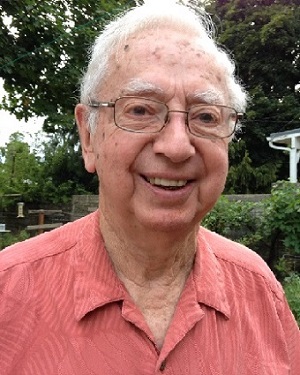 |
W7AAI Lewis H. 'Lew' Holt Corvallis, OR QCWA # 29229 Chapter 108 |
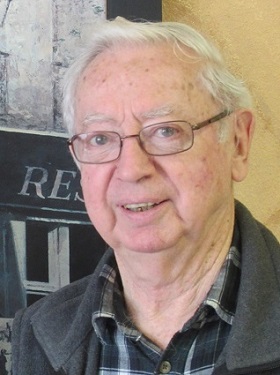 |
Every Sunday since about 2001 I have sent a Sunday email letter to a group of friends. My topics have been a great variety and showing my age, perhaps I repeated myself now and then. I'll share a combination of a couple of letters with you.
The summer of 1953 I signed a contract to teach a 5th grade in North Bend at the Hillcrest Elementary School. The 2nd year a 6th grade teacher, Ernie Ellis, was hired so now Hillcrest had two men teachers. Ernie lived just two blocks from me so we shared the 3-mile commute to school. Ernie was a ham radio operator, W7WTS; naturally we discussed ham radio when commuting and when visiting in our homes. Nate Olson, KØOS radio DJ lived next door to Ernie so I was in aHam radio environment. Eventually Ernie got me a code oscillator and started me working on my CW.
The novice exam required being able to copy five words per minute. Also, there was a license manual with pages of rules and electronic information that I had to learn. That spring we wrote for my exam Ernie and Nate administered the CW and written tests.
Finally on June 22, 1955 the big day arrived. My novice license came in the mail. The first thing I looked for was what my ham call letters were. I was very pleased with W7AAI. I had expected the FCC had gone though the alphabet, ending with W7ZZZ (supposedly), that I would get a K7 call. I was very pleased that the FCC started through the Ws again using the first calls that were available. I was one of the first to get a reissued a W7 call. That was 61 years ago last June.
Ernie had loaned me a receiver and together we build a simple transmitter. I had my ham station already to go, so almost immediately after I received my license, I went to the bedroom where my station was and sent CQ on CW. 'CQ' an invitation for any other amateur to reply. My novice license only allowed me to work CW on specific frequencies, low power and crystal controlled. On June 22, 1955, according to my logbook, I received an answer to my CQ. It was a ham in Myrtle Point, W7TLQ 30 miles away. What an exciting moment that was.
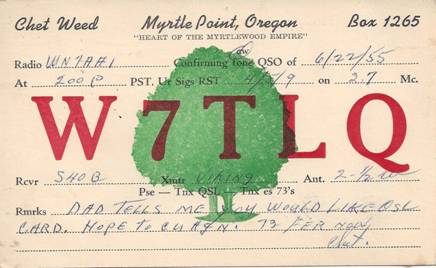 Confirmation of my first contact.
Confirmation of my first contact.I was a novice for the next six months with over 300 contacts - building up my code speed. The next level required me being able to copy CW at thirteen words per minute.
While Ernie was gone that summer he loaned me his Collins receiver - the Cadillac of receivers. It impressed my contacts but when Ernie returned, I had to give it up. I bought a used receiver from W7HHQ.
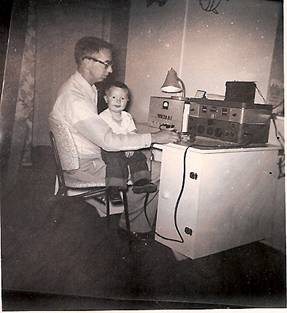 This was just a simple station. A receiver I bought from W7HHQ is on the right side and the 'home brew' transmitter is on the left and Steve on my lap. I built the desk. My antenna was something like 120 feet long with coaxial cable feeding it in the middle.
This was just a simple station. A receiver I bought from W7HHQ is on the right side and the 'home brew' transmitter is on the left and Steve on my lap. I built the desk. My antenna was something like 120 feet long with coaxial cable feeding it in the middle.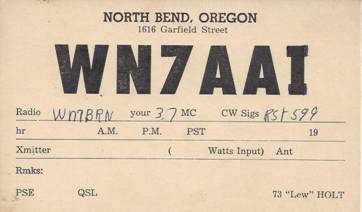
| As was the custom, I had QSL cards printed. I exchanged QSL cards with most every contact. I had to verify our contact. | ||
 |
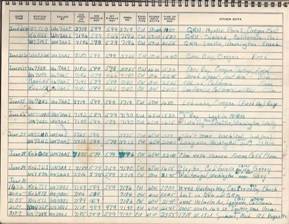 |
|
In the six months I was a novice, I worked hundreds of stations just for fun, because it was interesting and to increase my code speed, which I had to have at 13 words per minute for the next higher license.
April 13, 1955
Dear Mom,
.....I had planned to write a letter last night but we were invited to Ernie and Donna's home. We ate supper and then worked on my radio. I have a surplus Navy receiver. (A 40 meter ARC 5 and the ham band was maybe 1/4 of an inch across the dial.) I have listened to stations from England, Australia, Japan, etc. I have heard hams talking all over the west and Midwest. Ernie got it for me without any cost. (He actually snitched it from the Navy Reserves)
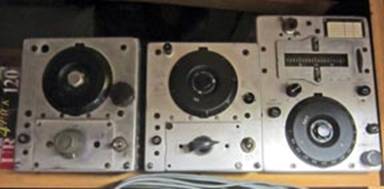
Some time after I got my novice license I made the big plunge to buy a commercial transmitter.
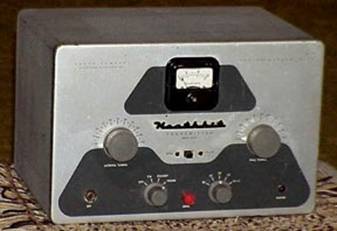 The DX-35 and my new conditional license opened up a whole new world with ham radio. Instead of being crystal controlled I used a VFO with the DX-35, which allowed me to zero beat a station to be on his frequency. Because I lived over 150 miles from the FCC office in Portland, I was allowed to take the conditional CW and written test in North Bend, given by two licensed hams. Ernie Ellis and Nate Olson witnessed me taking the test. The license was called a 'conditional' license. I was not satisfied with the conditional so several years later I went to Portland to take the test at the FCC office. Passing the test there, I now had a general license, no more privileges over the conditional license, just the pride of having a general license. Then the years that followed, I passed a tougher exam for the Advanced license, and the 20 wpm and yet a tougher test for an Extra Class license. Now I had gone from a novice to the Conditional, General, Advanced and Extra Class license.
The DX-35 and my new conditional license opened up a whole new world with ham radio. Instead of being crystal controlled I used a VFO with the DX-35, which allowed me to zero beat a station to be on his frequency. Because I lived over 150 miles from the FCC office in Portland, I was allowed to take the conditional CW and written test in North Bend, given by two licensed hams. Ernie Ellis and Nate Olson witnessed me taking the test. The license was called a 'conditional' license. I was not satisfied with the conditional so several years later I went to Portland to take the test at the FCC office. Passing the test there, I now had a general license, no more privileges over the conditional license, just the pride of having a general license. Then the years that followed, I passed a tougher exam for the Advanced license, and the 20 wpm and yet a tougher test for an Extra Class license. Now I had gone from a novice to the Conditional, General, Advanced and Extra Class license.Over the years as I upgraded my station from AM to SSB, I worked CW and RTTY, higher power, better receivers and my many ham radio experiences expanded.
I went through several years of working all states, and working many DX stations. I have over 100 different countries confirmed with QSL cards.
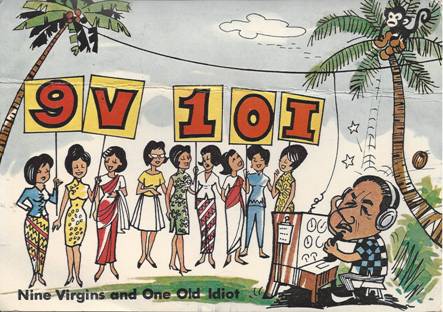 My favorite QSL card I received was actually from a neighbor who was a civilian in Viet Nam or in that region - 9V1OI. (Nine Virgins One Old Idiot)
My favorite QSL card I received was actually from a neighbor who was a civilian in Viet Nam or in that region - 9V1OI. (Nine Virgins One Old Idiot)I worked him one time from my car when I was parked in my driveway - a very rare DX contact with many stations waiting to contact him. We chatted (I had been his daughter's teacher) talking about old times. The pile up wanting to work this rare call was deep.
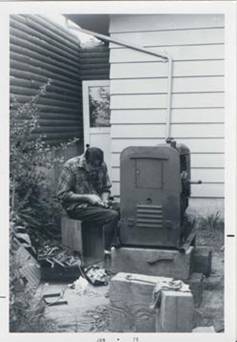 I had a transmitter and receiver in my car, worked all continents, even from my mobile. I went from ARC 5s powered by dynamotors to SSB gear. Along came MARS - Military Affiliated Radio Service - operating on military frequencies out of the ham bands. I passed a lot of traffic during the Viet Nam war. I received my share of military surplus radio gear 'for free'. A great motivator such as this generator.
I had a transmitter and receiver in my car, worked all continents, even from my mobile. I went from ARC 5s powered by dynamotors to SSB gear. Along came MARS - Military Affiliated Radio Service - operating on military frequencies out of the ham bands. I passed a lot of traffic during the Viet Nam war. I received my share of military surplus radio gear 'for free'. A great motivator such as this generator.Along came two meters, good for local hamming, except for repeaters high on top of mountains that we could use to send our signal all over Oregon. My son Steve at OSU at Corvallis surprised me when he got his tech license, which gave him 2 meters privileges. We talked almost every evening going through the repeater at the 4000 foot level on top of Mary's Peak, which was near by him. But now years later, we write every evening on email.
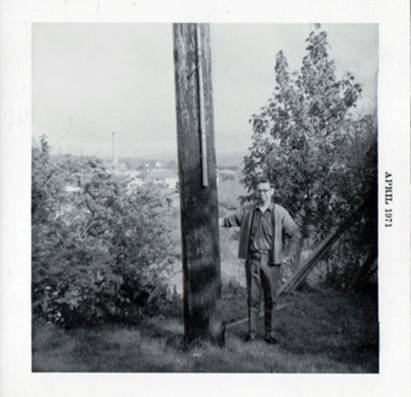 I had a 2 meter repeater in my shack with a 60 ft pole in the back yard for the antenna. The repeater allowed us easy contact around the Coos Bay area.
I had a 2 meter repeater in my shack with a 60 ft pole in the back yard for the antenna. The repeater allowed us easy contact around the Coos Bay area.At Christmas times I would drape many lights from the top of the 60 foot pole extending out to maybe 60 feet across at the bottom in an inverted V. In the back of my picture it shows across the dip to the Sherman Ave, which gave a good view of the lights. Many cars would stop to look or drive closer. They had never seen the pole before so couldn't imagine how the lights were suspended.
One time when I was at the top of my 60-foot pole working on my Tri-band beam, I heard an airplane sound that was different. I looked to the north out across the bay. I saw a B-17 followed by a P-51 fighter behind it. I hurried down my pole, went out to the airport to see the two planes that had circled over Coos Bay and back to North Bend to land.
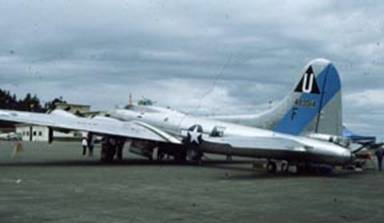 It made me feel as if the two planes might have been flying some 40 years at that time starting one day during WWII and were finally landing in North Bend. They certainly were not the typical airplanes using the North Bend airport.
It made me feel as if the two planes might have been flying some 40 years at that time starting one day during WWII and were finally landing in North Bend. They certainly were not the typical airplanes using the North Bend airport.I went through an evolution of ham gear through the years, both Army MARS gear and commercial gear. After I built the basement in our home on Liberty St. it gave me a ham shack with very little limitations.
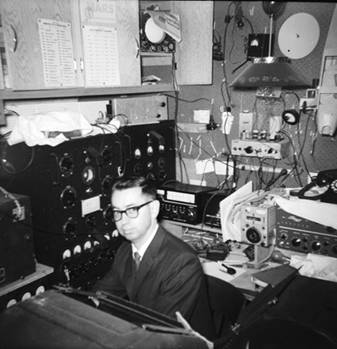
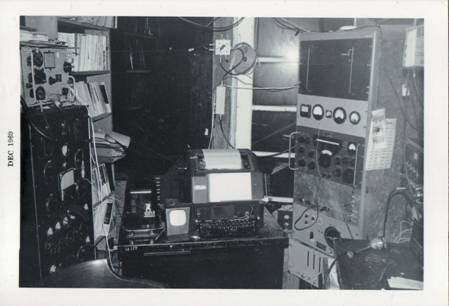 Much accumulated gear. My Central Electronics 10B with the BC 458 VFO.
Much accumulated gear. My Central Electronics 10B with the BC 458 VFO.The Collins receiver I picked up one time at the Presidio in San Francisco. The two big rigs on my right are MARS issued TCMs If I am correct.) One is the power supply and the other is the transmitter. Not showing is a TCS transmitter I used, also for CW on a MARS net on 2308 KCS for many years - a stretch of six years not missing a net at 0500Z on Wednesday nights.
I spent hours using my Teletype. Saturday after Saturday I copied a station in California sending pictures on RTTY/Teletype, much as you no doubt have seen pictures made on a typewriter "back in those days". One picture of the Last Supper took most of the day one Saturday. I also punched a paper tape that I could use to reprint a picture. Or I actually copied the RTTY signal on a cassette tape sometimes. I could replay the tape to print the picture, too.
Besides the TA33 tri-band beam, I had an all band dipole. Living in town I was fortunate to have a 200 foot long wire for my low frequency MARS net.
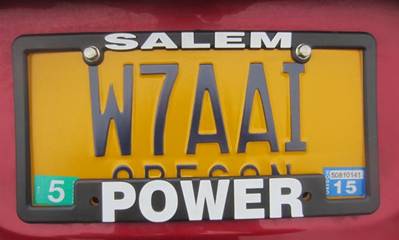 "Don't confuse me with too often confused Citizen Banders" or CBers. No fancy names. Our call letters are our pride, and mine being W7AAI. This is even been on my license plate proudly for many, many years. I was issued new plates when I transferred my plates to my RV several years ago. It is just that simple.
"Don't confuse me with too often confused Citizen Banders" or CBers. No fancy names. Our call letters are our pride, and mine being W7AAI. This is even been on my license plate proudly for many, many years. I was issued new plates when I transferred my plates to my RV several years ago. It is just that simple.When I was anticipating retirement back in 1984, I thought I would lead a life of leisure with a lot of time to work RTTY, chase DX, etc. I don't think I had two RTTY contacts after retirement. I didn't have time with the many opportunities that the many forks in the road offered me. When I moved to Salem from North Bend in 1993, I left my 60 foot antenna pole and all that it offered me, a Tri-band beam and 200 ft long wire, etc. I gave my surplus gear away, downsizing to just a basic station in the city lot here in Salem.
Years ago many of us had 75 meter antennas on our cars so we were easy to spot - or our license plates identified us. As we met each other we would "honk our horns" dit-dit-dit-dit dit-dit and then a big wave. (HI in CW) I haven't heard dit-dit-dit-dit dit-dit for many years. Some of us had a dial from a telephone mounted to the steering column so that when we dialed a four and then a two, the horn would be sounded accordingly. In this day and age there is no steering column, and of course no place to mount a pair of ARC 5s under the dash.
As I went from the dynamotor powering my ARC 5 receiver, I used an old car radio power that I had under the hood. Earlier the dynamotors were 24 volt so after my car had a 12 volt battery, I would rotate the dynamotor brushes, that were 180 degrees apart, to 90 degrees, which allowed them to work on 12 volts. The 1625s in the ARC 5 transmitter were 12 volt tubes so I would wire their filaments in parallel rather than in series. The same with the smaller tubes, too, in both the transmitter and receiver. Those were "the good old days".
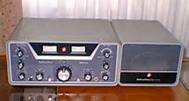 I traded a very good Lincoln penny collection for a Hallicrafters mobile transceiver, SR 150, which gave me all bands and many opportunities for working mobile. It was rather large but my car could handle it in those days. (Minus the AC power supply in the picture.)
I traded a very good Lincoln penny collection for a Hallicrafters mobile transceiver, SR 150, which gave me all bands and many opportunities for working mobile. It was rather large but my car could handle it in those days. (Minus the AC power supply in the picture.) I must have traded this in on a Swan 500 all band transceiver for my shack station. It served me well even on RTTY. I never used it mobile. It replaced my Central Electronics 10-b 10 watt SSB rig.
I must have traded this in on a Swan 500 all band transceiver for my shack station. It served me well even on RTTY. I never used it mobile. It replaced my Central Electronics 10-b 10 watt SSB rig.I think I sold my Swan to a friend, when a MARS friend of mine Lucille Peck, W7GNV had to go into a nursing home and was unable to operate her ICOM IC-730, so I bought it.
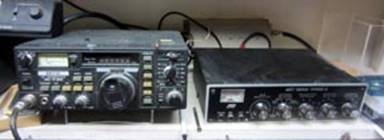 One more comment. You saw the pictures above of my ham shack in North Bend. Moving here to Salem 23 years ago I downsized my gear. Here is my present shack in my basement, the ICOM IC-730 I bought from Lucille.
One more comment. You saw the pictures above of my ham shack in North Bend. Moving here to Salem 23 years ago I downsized my gear. Here is my present shack in my basement, the ICOM IC-730 I bought from Lucille.I donated my best 2-meter gear several years ago to a disabled son, a veteran, an email fiddle friend I have in Nebraska.
This has been just the tip of an iceberg about my active days as a ham radio operator.
Lew Holt W7AAI
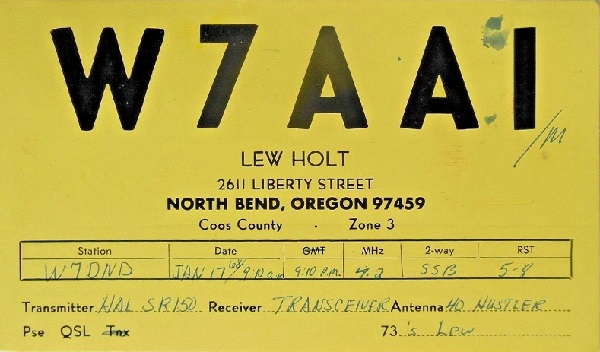
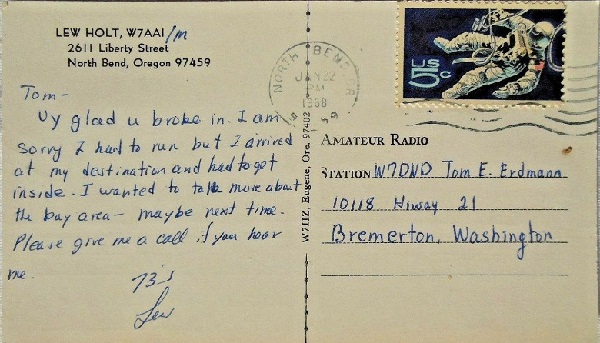
November 04, 2020